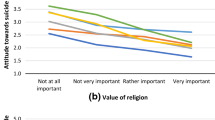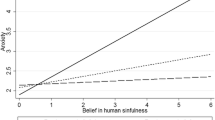Abstract
We aimed to examine the association between religious beliefs and observance and the prevalence of psychiatric disorders, psychotic symptoms and history of suicide attempts in the French general population. The cross-sectional survey interviewed 38,694 subjects between 1999 and 2003, using the MINI. Current religious beliefs and observance were identified by means of two questions: “are you a believer?” and “are you religiously observant?”. We studied the association between religiosity and psychiatric outcomes using a multivariable logistic regression model adjusted for sociodemographic characteristics, including migrant status. Religious beliefs were positively associated with psychotic symptoms and disorders [OR = 1.37, 95% CI (1.30–1.45) and OR = 1.38, 95% CI (1.20–1.58)], unipolar depressive disorder [OR = 1.15, 95% CI (1.06–1.23)] and generalized anxiety disorder [OR = 1.13, 95% CI (1.06–1.21)], but negatively associated with bipolar disorder [OR = 0.83, 95% CI (0.69–0.98)], alcohol use disorders [OR = 0.69, 95% CI (0.62–0.77)], substance use disorders [OR = 0.60, 95% CI (0.52–0.69)] and suicide attempts [OR = 0.90, 95% CI (0.82–0.99)]. Religious observance was positively associated with psychotic symptoms and disorders [OR = 1.38, 95% CI (1.20–1.58) and OR = 1.25, 95% CI (1.07–1.45)], but negatively associated with social anxiety disorder [OR = 0.87, 95% CI (0.76–0.99)], alcohol use disorders [OR = 0.60, 95% CI (0.51–0.70)], substance use disorders [OR = 0.48, 95% CI (0.38–0.60)] and suicide attempts [OR = 0.80, 95% CI (0.70–0.90)]. Among believers, religious observance was not associated with psychotic outcomes. Religiosity appears to be a complex and bidirectional determinant of psychiatric symptoms and disorders. In this respect, religiosity should be more thoroughly assessed in epidemiological psychiatric studies, as well as in clinical practice.
Similar content being viewed by others
Availability of data and materials
The data is not available in open access.
Change history
13 July 2021
A Correction to this paper has been published: https://doi.org/10.1007/s00406-021-01304-5
References
Durkheim E (2002) Le Suicide. J.-M, Tremblay, Chicoutimi
O’Reilly D, Rosato M (2015) Religion and the risk of suicide: longitudinal study of over 1 million people. Br J Psychiatry 206:466–470. https://doi.org/10.1192/bjp.bp.113.128694
Jacob L, Haro JM, Koyanagi A (2019) The association of religiosity with suicidal ideation and suicide attempts in the United Kingdom. Acta Psychiatr Scand 139:164–173. https://doi.org/10.1111/acps.12972
Hsieh N (2017) A global perspective on religious participation and suicide. J Health Soc Behav 58:322–339. https://doi.org/10.1177/0022146517715896
Braam AW, Van Den Eeden P, Prince MJ et al (2001) Religion as a cross-cultural determinant of depression in elderly Europeans: results from the EURODEP collaboration. Psychol Med 31:803–814. https://doi.org/10.1017/S0033291701003956
Smith TB, McCullough ME, Poll J (2003) Religiousness and depression: evidence for a main effect and the moderating influence of stressful life events. Psychol Bull 129:614–636. https://doi.org/10.1037/0033-2909.129.4.614
Miller L, Wickramaratne P, Gameroff MJ et al (2012) Religiosity and major depression in adults at high risk: a ten-year prospective study. Am J Psychiatry 169:89–94. https://doi.org/10.1176/appi.ajp.2011.10121823
Miller L, Davies M, Greenwald S (2000) Religiosity and substance use and abuse among adolescents in the national comorbidity survey. J Am Acad Child Adolesc Psychiatry 39:1190–1197. https://doi.org/10.1097/00004583-200009000-00020
Vance T, Maes HH, Kendler KS (2014) A multivariate twin study of the dimensions of religiosity and common psychiatric and substance use disorders. J Nerv Ment Dis 202:360–367. https://doi.org/10.1097/NMD.0000000000000131
Rasic D, Robinson JA, Bolton J et al (2011) Longitudinal relationships of religious worship attendance and spirituality with major depression, anxiety disorders, and suicidal ideation and attempts: findings from the Baltimore epidemiologic catchment area study. J Psychiatr Res 45:848–854. https://doi.org/10.1016/j.jpsychires.2010.11.014
Khalaf DR, Hebborn LF, Dal SJ, Naja WJ (2015) A critical comprehensive review of religiosity and anxiety disorders in adults. J Relig Health 54:1438–1450. https://doi.org/10.1007/s10943-014-9981-5
Bonelli RM, Koenig HG (2013) Mental disorders, religion and spirituality 1990 to 2010: a systematic evidence-based review. J Relig Health 52:657–673. https://doi.org/10.1007/s10943-013-9691-4
Borras L, Mohr S, Brandt P-Y et al (2007) Religious beliefs in schizophrenia: their relevance for adherence to treatment. Schizophr Bull 33:1238–1246. https://doi.org/10.1093/schbul/sbl070
Caqueo-Urízar A, Urzúa A, Boyer L, Williams DR (2016) Religion involvement and quality of life in patients with schizophrenia in Latin America. Soc Psychiatry Psychiatr Epidemiol 51:521–528. https://doi.org/10.1007/s00127-015-1156-5
Oh H, Waldman K, Koyanagi A (2018) Psychotic experiences and religiosity: findings from the collaborative psychiatric epidemiological surveys. Schizophr Res 201:435–436. https://doi.org/10.1016/j.schres.2018.05.037
Amad A, Guardia D, Salleron J et al (2013) Increased prevalence of psychotic disorders among third-generation migrants: results from the french mental health in general population survey. Schizophr Res 147:193–195. https://doi.org/10.1016/j.schres.2013.03.011
Mindlis I, Boffetta P (2017) Mood disorders in first- and second-generation immigrants: systematic review and meta-analysis. Br J Psychiatry 210:182–189. https://doi.org/10.1192/bjp.bp.116.181107
Selten J-P, van der Ven E, Termorshuizen F (2020) Migration and psychosis: a meta-analysis of incidence studies. Psychol Med 50:303–313. https://doi.org/10.1017/S0033291719000035
Johns LC, Cannon M, Singleton N et al (2004) Prevalence and correlates of self-reported psychotic symptoms in the British population. Br J Psychiatry 185:298–305. https://doi.org/10.1192/bjp.185.4.298
Jordanova V, Crawford MJ, McManus S et al (2015) Religious discrimination and common mental disorders in England: a nationally representative population-based study. Soc Psychiatry Psychiatr Epidemiol 50:1723–1729. https://doi.org/10.1007/s00127-015-1110-6
Lunsford TR, Lunsford BR (1995) The Research Sample, Part I: Sampling. JPO J Prosthet Orthot 7(3):105–112
Lecrubier Y, Sheehan D, Weiller E et al (1997) The mini international neuropsychiatric interview (MINI). A short diagnostic structured interview: reliability and validity according to the CIDI. Eur Psychiatry 12:224–231. https://doi.org/10.1016/S0924-9338(97)83296-8
Sheehan DV, Lecrubier Y, Sheehan KH et al (1998) The mini-international neuropsychiatric interview (M.I.N.I.): the development and validation of a structured diagnostic psychiatric interview for DSM-IV and ICD-10. J Clin Psychiatry 59(Suppl 20):22–33 (quiz 34-57)
Caria A, Roelandt J-L, Bellamy V, Vandeborre A (2010) Santé mentale en population générale : images et réalités (Smpg): présentation de La méthodologie d’enquête. L’Encéphale 36:1–6. https://doi.org/10.1016/S0013-7006(10)70011-7
Pignon B, Geoffroy PA, Thomas P et al (2017) Prevalence and clinical severity of mood disorders among first-, second- and third-generation migrants. J Affect Disord 210:174–180. https://doi.org/10.1016/j.jad.2016.12.039
Pignon B, Amad A, Pelissolo A et al (2018) Increased prevalence of anxiety disorders in third-generation migrants in comparison to natives and to first-generation migrants. J Psychiatr Res 102:38–43. https://doi.org/10.1016/j.jpsychires.2018.03.007
Pignon B, Peyre H, Szöke A et al (2018) A latent class analysis of psychotic symptoms in the general population. Aust N Z J Psychiatry 52:573–584. https://doi.org/10.1177/0004867417744255
R Core Team R: a language and environment for statistical computing. R foundation for statistical computing, version 3.3.0 [Internet]. Vienna, Austria; 2013. Available from: http://www.R-project.org
Korkeila J, Vahtera J, Nabi H et al (2010) Childhood adversities, adulthood life events and depression. J Affect Disord 127:130–138
Beards S, Gayer-Anderson C, Borges S et al (2013) Life events and psychosis: a review and meta-analysis. Schizophr Bull 39:740–747
Beutel ME, Klein EM, Brähler E et al (2017) Loneliness in the general population: prevalence, determinants and relations to mental health. BMC Psychiatry 17:97
Erzen E, Çikrikci Ö (2018) The effect of loneliness on depression: a meta-analysis. Int J Soc Psychiatry 64:427–435
Michalska da Rocha B, Rhodes S, Vasilopoulou E, Hutton P (2018) Loneliness in psychosis: a meta-analytical review. Schizophr Bull 44:114–125
Shahid M, Raza SS (2018) Religion/spirituality: a tool to better help psychiatric patients. J Coll Physicians Surg 28:578. https://doi.org/10.29271/jcpsp.2018.07.578
Steenhuis LA, Bartels-Velthuis AA, Jenner JA et al (2016) Religiosity in young adolescents with auditory vocal hallucinations. Psychiatry Res 236:158–164. https://doi.org/10.1016/j.psychres.2015.12.014
Abdel Gawad N, Desai P, Ali T et al (2018) Religious activity, psychotic features, and suicidality in 688 acute psychiatric inpatients. J Psychiatr Pract 24:253–260. https://doi.org/10.1097/PRA.0000000000000311
Pierre JM (2001) Faith or delusion? At the crossroads of religion and psychosis. J Psychiatr Pract 7:163–172. https://doi.org/10.1097/00131746-200105000-00004
Debray R (2004) God: an itinerary. Verso, London; New York, p 312p
Kleiman EM, Liu RT (2014) Prospective prediction of suicide in a nationally representative sample: religious service attendance as a protective factor. Br J Psychiatry 204:262–266. https://doi.org/10.1192/bjp.bp.113.128900
VanderWeele TJ, Li S, Tsai AC, Kawachi I (2016) Association between religious service attendance and lower suicide rates among US women. JAMA Psychiatry 73:845. https://doi.org/10.1001/jamapsychiatry.2016.1243
Lawrence RE, Oquendo MA, Stanley B (2016) Religion and suicide risk: a systematic review. Arch Suicide Res 20:1–21. https://doi.org/10.1080/13811118.2015.1004494
Stack S, Laubepin F (2019) Religiousness as a predictor of suicide: an analysis of 162 European regions. Suicide Life Threat Behav 49:371–381. https://doi.org/10.1111/sltb.12435
Heinz A, Epstein DH, Preston KL (2007) Spiritual/religious experiences and in-treatment outcome in an inner-city program for heroin and cocaine dependence. J Psychoactive Drugs 39:41–49. https://doi.org/10.1080/02791072.2007.10399863
Dew RE, Daniel SS, Armstrong TD et al (2008) Religion/spirituality and adolescent psychiatric symptoms: a review. Child Psychiatry Hum Dev 39:381–398. https://doi.org/10.1007/s10578-007-0093-2
Tuck A, Robinson M, Agic B et al (2017) Religion, alcohol use and risk drinking among Canadian adults living in Ontario. J Relig Health 56:2023–2038. https://doi.org/10.1007/s10943-016-0339-z
Edlund MJ, Harris KM, Koenig HG et al (2010) Religiosity and decreased risk of substance use disorders: is the effect mediated by social support or mental health status? Soc Psychiatry Psychiatr Epidemiol 45:827–836
Kendler KS, Liu X-Q, Gardner CO et al (2003) Dimensions of religiosity and their relationship to lifetime psychiatric and substance use disorders. Am J Psychiatry 160:496–503
Cavanagh JTO, Carson AJ, Sharpe M, Lawrie SM (2003) Psychological autopsy studies of suicide: a systematic review. Psychol Med 33:395–405
Arsenault-Lapierre G, Kim C, Turecki G (2004) Psychiatric diagnoses in 3275 suicides: a meta-analysis. BMC Psychiatry 4:37
Roux P, Misdrahi D, Capdevielle D et al (2018) Mediation analyses of insight, quality of life, depression, and suicidality: results from the FACE-SZ Cohort. J Clin Psychiatry 79:17m11638
Miller JN, Black DW (2020) Bipolar disorder and suicide: a review. Curr Psychiatry Rep 22:6. https://doi.org/10.1007/s11920-020-1130-0
Leurent B, Nazareth I, Bellón-Saameño J et al (2013) Spiritual and religious beliefs as risk factors for the onset of major depression: an international cohort study. Psychol Med 43:2109–2120. https://doi.org/10.1017/S0033291712003066
De Fazio P, Gaetano R, Caroleo M et al (2015) Religiousness and spirituality in patients with bipolar disorder. Int J Psychiatry Clin Pract 19:233–237. https://doi.org/10.3109/13651501.2014.1000929
Gallemore JL, Wilson WP, Rhoads JM (1969) The religious life of patients with affective disorders. Dis Nerv Syst 30:483–487
Earl TR, Fortuna LR, Gao S et al (2015) An exploration of how psychotic-like symptoms are experienced, endorsed, and understood from the National Latino and Asian American study and national survey of American life. Ethn Health 20:273–292. https://doi.org/10.1080/13557858.2014.921888
Kovess-Masfety V, Saha S, Lim CCW et al (2018) Psychotic experiences and religiosity: data from the WHO world mental health surveys. Acta Psychiatr Scand 137:306–315. https://doi.org/10.1111/acps.12859
Loch AA, Freitas EL, Hortêncio L et al (2019) Hearing spirits? Religiosity in individuals at risk for psychosis—results from the Brazilian SSAPP cohort. Schizophr Res 204:353–359. https://doi.org/10.1016/j.schres.2018.09.020
Ventriglio A, Bonfitto I, Ricci F et al (2018) Delusion, possession and religion. Nord J Psychiatry 72:S13–S15
DeVylder JE, Lukens EP, Link BG, Lieberman JA (2015) Suicidal ideation and suicide attempts among adults with psychotic experiences: data from the collaborative psychiatric epidemiology surveys. JAMA Psychiatry 72:219. https://doi.org/10.1001/jamapsychiatry.2014.2663
Pignon B, Schürhoff F, Szöke A et al (2018) Sociodemographic and clinical correlates of psychotic symptoms in the general population: findings from the MHGP survey. Schizophr Res 193:336–342. https://doi.org/10.1016/j.schres.2017.06.053
Todd E (2019) Lineages of modernity: a history of humanity from the stone age to homo americanus. Polity Press, Cambridge, Medford, MA
Funding
This research received no specific grant from any funding agency, commercial or not-for-profit sectors.
Author information
Authors and Affiliations
Corresponding author
Ethics declarations
Conflict of interest
The authors declare that they have no conflict on interest.
Ethical standards
The authors assert that all procedures contributing to this work comply with the ethical standards of the relevant national and institutional committees on human experimentation and with the Helsinki Declaration of 1975, as revised in 2008. Legal authorization was obtained by the “Commission Nationale Informatique et Liberté” (CNIL) and the “Comité consultatif sur le traitement de l'information en matière de recherche” (CCTIRS), with number 98.126.
Rights and permissions
About this article
Cite this article
Brito, M.A., Amad, A., Rolland, B. et al. Religiosity and prevalence of suicide, psychiatric disorders and psychotic symptoms in the French general population. Eur Arch Psychiatry Clin Neurosci 271, 1547–1557 (2021). https://doi.org/10.1007/s00406-021-01233-3
Received:
Accepted:
Published:
Issue Date:
DOI: https://doi.org/10.1007/s00406-021-01233-3




